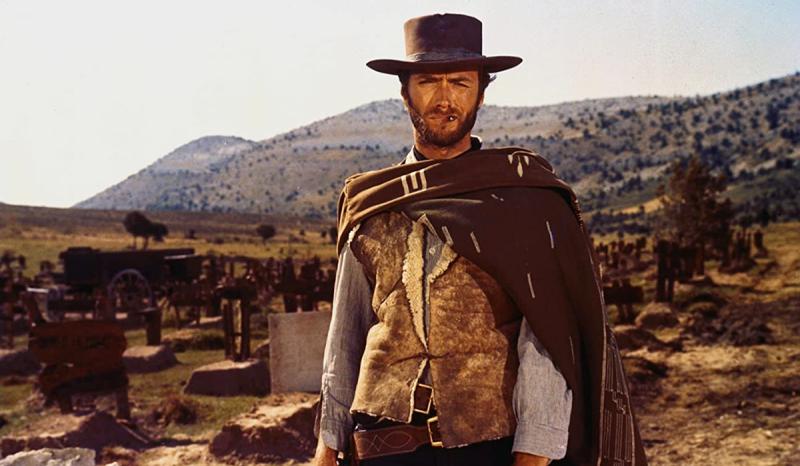Movie Review: 'The Good, The Bad and the Ugly' Is Sergio Leon's Fistful of Opera
By: Kyle Smith (National Review)



The most reprehensibly violent movie ever made came to America at the end of 1967: "must be the most expensive, pious, and repellent movie in the history of its peculiar genre," wrote New York Times critic Renata Adler. "If 42d Street is lined with little pushcarts of sadism, this film . . . is an entire supermarket." One character, Adler informed us, is "throttled three times, sunscorched, and once so severely beaten . . . that anyone who would voluntarily remain in the theater beyond this scene . . . is not someone I should care to meet, in any capacity, ever."
Adler was writing about The Good, the Bad and the Ugly, which she rechristened The Burn, the Gouge and the Mangle in a review that was more or less solely a complaint about its violence and about which she further harrumphed that though "the movie takes place in arid country, there are an awful lot of salads and vegetables." Audiences declined to be upset about the surfeit of bloodshed, or vegetables, and in the U.S. the film grossed the equivalent of $185 million in today's dollars. Adler wisely abandoned her film-critic post the following year and went on to other things.
Critics eventually caught up to audiences in acknowledging the grandiose glories of The Good, the Bad and the Ugly (henceforth GBU, now streaming on Netflix), today one of the most hallowed of all Westerns and one of the two chief reasons (along with its immediate successor, Once Upon a Time in the West, streaming on Amazon Prime/Starz) that the sobriquet of genius became attached to the name of writer-director Sergio Leone. In 2003, a sheepish Roger Ebert looked up his original review and discovered he had "described a four-star movie but only gave it three stars, perhaps because it was a 'spaghetti Western' and so could not be art."
Italian-made "spaghetti Westerns," of which hundreds were made but few of which were released in the United States and of which only Leone's five efforts in the genre survive in the memory of anyone but specialists, gave the Renata Adlers of the world lots of reasons to gasp in horror like so many Margaret Dumonts. Their budgets, at least initially, were comically low (A Fistful of Dollars, the first in what U.S. marketers misleadingly dubbed the "Man with No Name" trilogy that concluded with GBU, cost only $200,000). Their production values were spotty (actors spoke their native languages on the shoot, then dubbed their lines in post-production, sometimes awkwardly). Leone's scripts were notoriously lax when it came to plausibility or even basic continuity. (How does the outlaw Angel Eyes get to be the effective commander of a Union prison camp in New Mexico in 1862 anyway?) Ennio Morricone's bizarre avant-garde-inflected score, with its imitation coyote howls and newfangled electric-guitar riffs, would have confounded anyone raised on the lush, swelling sentimentalism of Hollywood composers such as Max Steiner, Miklos Rozsa, and Alfred Newman. Leone's hero Blondie is breathtakingly ill-behaved by the standard set in previous Westerns, abandoning his partner to die in the desert for no apparent reason as the word "the good" is ironically scrawled over him on the screen. The violence was not only unusually detailed and bloody, it was administered with an alarming shrug or even outright glee, not with the solemn duty seen in John Ford movies. The cast were cast-offs, notably the unloved former television actor playing Blondie, Clint Eastwood, who took the gig because he'd never seen Italy or Spain and was paid only $15,000. Eastwood was barely mentioned in Adler's review, which expressed frustration that "his face and voice are expressionless throughout." You don't say. Eastwood's minimalism yielded one of the greatest and most durable careers in cinema.
Leone grew up on, or in, film (his father was one of the pioneers of Italian cinema and his mother was a silent-film star). After learning from American cinema that Americans were impossibly romantic and big-hearted people, he came to take a darker view after actual Americans came to Italy during and after the war. His films shimmer with references to previous movies and shudder with busted idealism, two characteristics that would come to be standard equipment for top filmmakers in the Seventies and beyond, when a cynical view of old ideals such as patriotic fervor and fighting for one's country spread across the culture.
Though born back in 1929, Leone proved a prophet of Baby Boomer mistrust in every kind of establishment, minus any millennial hope for groovy new replacements. In Leone films, no one can be trusted; in For a Few Dollars More (1965), the middle film in the Man with No Name trilogy, one partner promises the other he'll move north. Later they meet up heading south because the latter just assumed the former would do the opposite of what he said. In the marvelous climactic showdown at the end of GBU, Leone's trio of criminals are scorpions in a bottle, with no love or loyalty given or expected, and this was one of many aspects of his work that would appeal to epigones such as Quentin Tarantino, whose career is a multi-decade tribute to Leone.
Leone was ahead of his time in making movies that were centrally about the movies — about their conventions, about their hypocrisies, about their cliches. He turned away from the gloss of the Shane era of lyrical Westerns that aimed to be thought of as wholesome or high-toned in favor of an aggressively rank, nasty, festering landscape of cutthroats and degenerates. Background characters are an anti-gallery of freaks and uglies. Churches are used not to reconnect with ideals or seek moral grounding but for storing dead and wounded. The Civil War that keeps infringing on his three principals' plans to cheat one another out of the loot is to Leone no more meaningful than mindless rams butting heads. Blondie, surveying a gigantic Yankee vs. Rebel battle scene by a river that appears to count for naught, remarks, "I've never seen so many men wasted so badly." The wholesale slaughter of the Civil War provides a kind of moral license for the retail slaughter of GBU. (To his credit, Tarantino made the moral vectors of the Civil War central to the plot of his antebellum spaghetti-western tribute Django Unchained, also on Netflix).
Comments
Leone had absorbed many a shootout in his Hollywood education, so he devised the triangular showdown in the graveyard at the end of GBU as the shootout of all shootouts. For five sumptuous minutes, backed by a Morricone combination of mariachi trumpet and chorus, Leone wallows in suspense as the three combatants do nothing but walk to their positions, eye each other, and fire. There's no narrative motivation for any of them to hold back; this is simply Leone raising the ritualism of the cinematic gunfight to a gonzo extreme (and with his typical black humor; one of the men gets shot right into an open grave, then his hat gets neatly shot in after him).
A more alert critic than Adler, Richard Jameson, wrote in Film Comment in 1973 that GBU was "an opera in which arias are not sung but stared." That's exactly right: We overlook the ridiculous plot machinations of opera because we love the grand and their grotesque, all those lurid and diabolical turns. Complaining that a Leone movie is violent is like complaining that an opera is sad. As in an opera, the characters are archetypes, not figures we particularly identify with; as in an opera, we waited a long time for the inevitable ghastly conclusion; as in an opera, Leone seeks (and delivers) a kind of ecstatic dread. But because it's horse opera — Puccini gone Hollywood — the good guy gets to win. Well, let's just say the least-bad guy.



